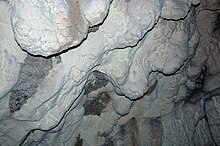Macromonas bipunctata
| Macromonas bipunctata | |
|---|---|
| [3] | |
| Scientific classification | |
| Domain: | Bacteria |
| Phylum: | Proteobacteria |
| Class: | Betaproteobacteria |
| Order: | Enterobacteriaceae |
| Family: | Comamonadaceae |
| Genus: | Macromonas |
| Species: | M. bipunctata |
| Binomial name | |
|
Macromonas bipunctata (Gicklhorn 1920) Utermöhl and Koppe |
|
Macromonas bipunctata is a Gram-negative, colorless, and heterotrophic sulfur bacterium of the genus Macromonas. It is commonly found in sewage aeration tanks and caves where moonmilk has formed. In the 1920s, researcher Gicklhorn first discovered this organism under the name Pseudomonas bipunctata. After further study and culturing by Utermöhl and Koppe, in 1923, it was later renamed Macromonas bipunctata. This organism is thought to be non-pathogenic species. In fact, the moonmilk produced was referenced as a remedy for infections in the Middle Ages.
In the Middle Ages "moon milk" was used as a medicine. People often used it to cure infections and accelerate the healing process. "Moon milk" is more than simply Macromonas bipunctata. It also contains populations of cyanobacteria, fungi, green algae and actinomycetes, which are the main producers of antibiotics. This could explain why it was effective as a potential agent for healing.
M. bipunctata was first isolated by Gicklhorn in the slime of a large basin Gratz in a botanical garden in 1924. Gicklhorn treated this species as a colorless sulfur bacteria and called it Pseudomonas bipunctata. The Greek root "monad/monas" was commonly used for microbiology to indicate a unicellular or single unit organism(s)/bacterium in the 1920s. Furthermore, bipunctata can be separated into the Latin roots "bi", meaning two, and "punctata" , meaning spotted, as seen in cultured M. bipunctata.
...
Wikipedia

